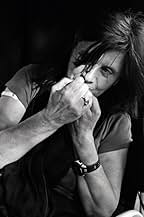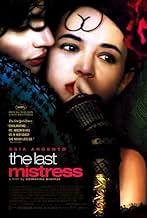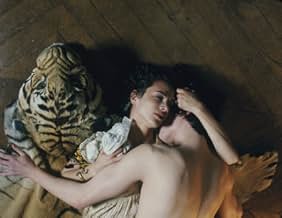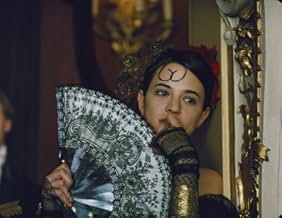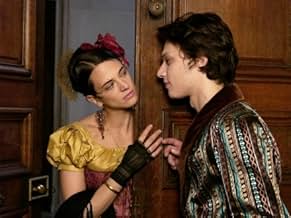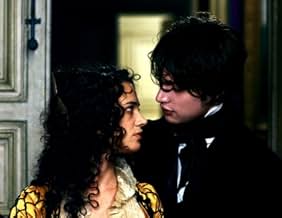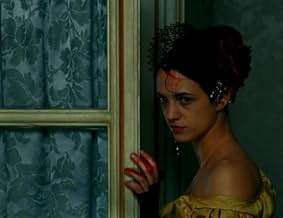IMDb RATING
6.2/10
3.9K
YOUR RATING
Secrets, rumors and betrayals surround the upcoming marriage between a young dissolute man and virtuous woman of the French aristocracy.Secrets, rumors and betrayals surround the upcoming marriage between a young dissolute man and virtuous woman of the French aristocracy.Secrets, rumors and betrayals surround the upcoming marriage between a young dissolute man and virtuous woman of the French aristocracy.
- Director
- Writers
- Stars
- Awards
- 3 nominations total
- Director
- Writers
- All cast & crew
- Production, box office & more at IMDbPro
Featured reviews
Une vieille maîtresse – The Last Mistress – CATCH IT (B) Based upon controversial French novel "Une vieille maîtresse/An old Mistress" by Jules Amédée Barbey d'Aurevilly. Just like most of the French movies The Last Mistress doesn't hesitate from sex, seduction and brutality of love. It's a story about a young rich French Ryno de Marigny who is ready to get married into a Nobel family. Just before getting married he confronts in front of his future rich wife's grandmother about his last old mistress of 10 years. The movie unfolds how Ryno falls head over heels for an older married woman, who is not even pretty or graceful. It's the rawness which attracts Ryno towards her, whom he first called an ugly nut. Fu'ad Aït Aattou a newcomer played Ryno with utmost honesty. He is divine and his falling for an Asia Argento's ambiguous character is questionable. But that's the whole point of love, lust and seduction when two unlikely people meet and ruin everything around them along with each other. Asia Argento is amazing, even though I saw her first in Marie Antoinette as French king's crazy mistress raised question of her action ability because she acted the same as she acted here. If I ignore that she was in tedious Marie Antoinette and Une vieille maîtresse release long before atrocious Marie Antoneitte. I actually loved her performance. There are many few actresses who can let them emotionally and physically open like that. You forget that it's the part of an act as it looks reality. Fu'ad Aït Aattou and Asia Argento's chemistry makes this a memorable venture. The long sex confrontation scenes are the proof how involved they are with the subject. Roxane Mesquida as Ryno's wife is stunning as always. Une vieille maîtresse is a controversial tale of lust, love and seduction. Overall, I enjoyed the movie even though I wanted the characters to be smart not so naïve and stupid, lost in sex, lust and seduction.
Last Mistress, The (2007)
*** (out of 4)
Libertine Ryno de Marigny (Fu'ad Ait Aattou) is about to marry into a rich family but must explain to his soon to be wife's grandmother why he has spent the last ten years with the same mistress (Asia Argento. The man must explain the two's connection and he must then face the fact that he won't be able to see her again or if she will let this happen. Breillat has become one of my favorite directors since seeing FAT GIRL several years back and she continues her success with this love triangle that certainly has a lot more style than substance. In the end, I'm really not sure if this movie tries to say anything other than that men are worthless pigs but if that's all there is to say then I'm alright with it because this is a beautiful film to look at and we're given some fine performances to watch. Argento is the one who really stood out for me and this is certainly the best I've seen from her. She's usually hit and miss (especially in her dad's movies) but she nails all the right notes here and delivers a full character. I really felt Argento hit all the dramatic notes just right and I think she did quite well in the more emotional scenes at well. There's a bizarre sequence in the desert where she really gets to show this off as well as mixing it in with her sexuality. Being a Breillat film, you know there's going to be quite a bit of sex and nudity. There's plenty of both but it's certainly a lot tamer than we're use to seeing but Argento dives into it head first. There's not an inch of her body that Breillat doesn't put the camera on but this is never a bad thing as she's got a certain way to throw her sexuality around. Newcomer Ait Aattou is also very impressive as the libertine as he perfectly captures the spirit and tortured soul of this character. He and Argento work extremely well together and this is especially true during their more dramatic moments. The visual look of the film is a real treat as the cinematography is top notch as is the costumes, art design and the marvelous sets. It seems Breillat spent a lot more time on the style here than the actual substance but I don't say this as a negative thing. I'm sure some might feel there should be more meat here but I think the film balances both ends quite well and in the end we're left with a very impressive film, although no classic.
*** (out of 4)
Libertine Ryno de Marigny (Fu'ad Ait Aattou) is about to marry into a rich family but must explain to his soon to be wife's grandmother why he has spent the last ten years with the same mistress (Asia Argento. The man must explain the two's connection and he must then face the fact that he won't be able to see her again or if she will let this happen. Breillat has become one of my favorite directors since seeing FAT GIRL several years back and she continues her success with this love triangle that certainly has a lot more style than substance. In the end, I'm really not sure if this movie tries to say anything other than that men are worthless pigs but if that's all there is to say then I'm alright with it because this is a beautiful film to look at and we're given some fine performances to watch. Argento is the one who really stood out for me and this is certainly the best I've seen from her. She's usually hit and miss (especially in her dad's movies) but she nails all the right notes here and delivers a full character. I really felt Argento hit all the dramatic notes just right and I think she did quite well in the more emotional scenes at well. There's a bizarre sequence in the desert where she really gets to show this off as well as mixing it in with her sexuality. Being a Breillat film, you know there's going to be quite a bit of sex and nudity. There's plenty of both but it's certainly a lot tamer than we're use to seeing but Argento dives into it head first. There's not an inch of her body that Breillat doesn't put the camera on but this is never a bad thing as she's got a certain way to throw her sexuality around. Newcomer Ait Aattou is also very impressive as the libertine as he perfectly captures the spirit and tortured soul of this character. He and Argento work extremely well together and this is especially true during their more dramatic moments. The visual look of the film is a real treat as the cinematography is top notch as is the costumes, art design and the marvelous sets. It seems Breillat spent a lot more time on the style here than the actual substance but I don't say this as a negative thing. I'm sure some might feel there should be more meat here but I think the film balances both ends quite well and in the end we're left with a very impressive film, although no classic.
Milan Kundera writes: "Human time does not turn in a circle; it runs ahead in a straight line. That is why man cannot be happy: happiness is the longing for repetition." Case in point, Ryno de Marigny (Fu'ad Ait Aattou), an impoverished but elegantly handsome young man who is trapped between the aristocratic world to which he aspires, and an obsessive bond with a defiantly independent mistress, the boldly seductive Vellini (Asia Argento), an older but dazzling Spanish woman said to be born of an Italian noblewoman and a bullfighter. Adapted from a 19th-century novel Une vieille maîtresse by Jules-Amédée Barbey d'Aurevilly, Catherine Breillat's beautiful and elegant The Last Mistress, challenges the patriarchal assumptions of the age by depicting a 36-year old woman's right to fully express her sexual desires even if it is means flaunting society's conventions and Christian misogynist teachings.
Set in Paris in 1835, complete with elaborate period costumes and sumptuously decorated drawing rooms, the film opens with the gossip between two aging aristocrats, the Vicomte de Prony (Michael Lonsdale) and his wife, the Countess d'Artelles (Yolande Moreau about the ten-year affair between de Marigny and Vellini and the young man's impending marriage to the wealthy Hermangarde (Roxane Mesquida). Hermangarde's grandmother La marquise de Flers, excellently played by the 80-year-old French writer Claude Sarrate, is an open-minded and rational individual who claims to be a woman of the 18th century. Worried that Ryno will not be able to get over his passion for his fiery Spanish mistress, de Flers listens attentively as Ryno relates to her the details of his long relationship, an affair that he says has now come to an end, telling her that "You don't betray a new love with an old mistress".
In flashback, Ryno relates how he was overcome by Vellini's wild beauty after they were introduced at a party ten years before. Vellini, then married to a wealthy but dull Englishman, reacts negatively, however, when she overhears Ryno call her an ugly mutt and the young man is forced to vigorously pursue her despite her strong objections, forcing her to kiss him while the two are out riding. Her horrified husband witnesses the act and challenges Ryno to a duel the next morning. After deliberately missing his first shot, Ryno is shot in the chest, a wound from which he will take months to recover. The incident, however, triggers Vellini's awareness of her love for Ryno, exotically announced by her sucking the blood from the gaping hole in his chest.
De Flers presses Ryno for the details of their life together during the past ten years but the dramatic story is better left for the viewer to discover. When the film returns to present time, de Marigny and Hermangarde are married and ostensibly in love, yet he struggles to keep his word to her grandmother by moving away from the temptations of Paris to a remote seacoast. The cigar-smoking temptress, however, also loves the fresh sea air and the stage is set for the film's final act. The Last Mistress is an outstanding work of art that is strengthened immeasurably by striking performances by Asia Argento and first-time actor Fu'ad Ait Aattou. Argento fully captures Vellini's sexual assertiveness but tempers her incendiary disposition with naturalism and a tenderness that makes us care about her fate.
Aattou, discovered by Breillat in a crowded café, is almost feminine in appearance with overly thick lips and sensitive eyes, yet he brings a masculine determination to the role that makes him completely convincing. Like the recent film by Jacques Rivette, The Duchess of Langeais, in The Last Mistress love becomes a contest of wills, a power struggle between two people whose relationship consists of a tug of war not only between domination and submission but between 18th and 19th century social codes. That Breillat makes the ride so entrancing is a tribute to her enormous talent.
Set in Paris in 1835, complete with elaborate period costumes and sumptuously decorated drawing rooms, the film opens with the gossip between two aging aristocrats, the Vicomte de Prony (Michael Lonsdale) and his wife, the Countess d'Artelles (Yolande Moreau about the ten-year affair between de Marigny and Vellini and the young man's impending marriage to the wealthy Hermangarde (Roxane Mesquida). Hermangarde's grandmother La marquise de Flers, excellently played by the 80-year-old French writer Claude Sarrate, is an open-minded and rational individual who claims to be a woman of the 18th century. Worried that Ryno will not be able to get over his passion for his fiery Spanish mistress, de Flers listens attentively as Ryno relates to her the details of his long relationship, an affair that he says has now come to an end, telling her that "You don't betray a new love with an old mistress".
In flashback, Ryno relates how he was overcome by Vellini's wild beauty after they were introduced at a party ten years before. Vellini, then married to a wealthy but dull Englishman, reacts negatively, however, when she overhears Ryno call her an ugly mutt and the young man is forced to vigorously pursue her despite her strong objections, forcing her to kiss him while the two are out riding. Her horrified husband witnesses the act and challenges Ryno to a duel the next morning. After deliberately missing his first shot, Ryno is shot in the chest, a wound from which he will take months to recover. The incident, however, triggers Vellini's awareness of her love for Ryno, exotically announced by her sucking the blood from the gaping hole in his chest.
De Flers presses Ryno for the details of their life together during the past ten years but the dramatic story is better left for the viewer to discover. When the film returns to present time, de Marigny and Hermangarde are married and ostensibly in love, yet he struggles to keep his word to her grandmother by moving away from the temptations of Paris to a remote seacoast. The cigar-smoking temptress, however, also loves the fresh sea air and the stage is set for the film's final act. The Last Mistress is an outstanding work of art that is strengthened immeasurably by striking performances by Asia Argento and first-time actor Fu'ad Ait Aattou. Argento fully captures Vellini's sexual assertiveness but tempers her incendiary disposition with naturalism and a tenderness that makes us care about her fate.
Aattou, discovered by Breillat in a crowded café, is almost feminine in appearance with overly thick lips and sensitive eyes, yet he brings a masculine determination to the role that makes him completely convincing. Like the recent film by Jacques Rivette, The Duchess of Langeais, in The Last Mistress love becomes a contest of wills, a power struggle between two people whose relationship consists of a tug of war not only between domination and submission but between 18th and 19th century social codes. That Breillat makes the ride so entrancing is a tribute to her enormous talent.
Breillat's films are mostly small budget contemporary provocations with a feminist bent. This one, her twelfth, she says cost as much as ten previous ones and is a costume drama based on a controversial novel by Jules-Amédée Barbey d'Aurevilly (1808-1889). This is a bit confusing: the film begins by saying it's the century of Choderlos de Laclos (author of Dangerous Liaisons). but his famous work was written in 1782, and the action of d'Aurevilly's novel is set in 1835. The point is, the story is about the French aristocracy, and in the early nineteenth century its members still believed in and lived by the libertinism of Laclos.
In fact The Last Mistress (Une vieille maitresse) is a transitional story that links the two centuries and in a sense presents a romantic conception of the eighteenth century. Ryno de Marigny (beautiful newcomer Fu'ad Ait Aattou) is a high born young man who has squandered his wealth on his Spanish mistress, the willful Vellini (Asia Argento, in her element), with whom he's been involved for ten years. Allocine calls Ryno "a kind of romantic Valmont." But that's just it: there was nothing romantic about de Laclos' cruel and manipulative Valmont and Ryno is a new post-eighteenth-century conception of the eighteenth-century libertine that is titillated by his freedom but adds the emotional dressing of romantic passion. Breillat obviously loves this combination, is at home with it, and has given it deliriously appropriate treatment in this minor but beautiful, lush, and thoroughly enjoyable film.
The Breillat touch is perhaps most visible in the love-making scenes between Vellini and Ryno, in which there is much nudity and specificity of physical detail. Fu'ad Ait Aattou has pale skin and bigger lips than Asia Argento. By intention, both are androgynous; this is Breillat's conception of Choderlos de Laclos's and d'Aurevilly's libertines. The two actors are perfectly matched for this. Vellini is the aggressor; it is she who makes love with Ryno, using him like a lovely male statue made of alabaster. He is passionate like a romantic lover, however: that is, he's hung up on her forever, no matter what he tries. Early on, he fights a duel with her English husband and is wounded in the shoulder. The sex sequences are specific and fleshy as in no other costume drama, but Breillat is not creating an anachronistic work. As she explained in the NYFF press Q&A, she is passionate about the quality of her period detail and bought tons of lush materials and costumes. The dress, the jewelry, and the interiors are all completely authentic, and there is a rich color scheme in which red and green and yellow predominate. Without seeming over-glossy (it's not eye-candy like Sofia Coppola's Marie Antoinette), The Last Mistress is a pleasure to look at. It's also a pleasure to listen to, with its choice use of ornate and witty language. Oldtimer Michael Lonsdale as the gossipy Le vicomte de Prony particularly relishes his well-turned phrases.
As the story gets under way, Ryno has now found a wife, the beautiful young blonde noblewoman Hermangarde (Breillat regular Roxane Mesquida), and he's in love with her, and tired of Villini. Hermangarde's grandmother, the Marquise de Flers (non-actress Claude Sarraute, daughter of novelist Nathalie) is responsible for vetting Ryno, and in a lengthy sequence that's the heart of the film, he confesses to her everything about his relationship with Vellini. After much has been told (and shown on screen) in an amusing moment we see the Marquise reclining low in her seat: she is exhausted, but entranced. She wants to hear every detail. The Marquise is of course, of the older generation--a real Choderlos de Laclos lady. For her, the information that Ryno is a true libertine is proof that he is reliable, not an unknown quantity. And the cards are on the table. He'll do.
Rybno has every intention of having done with Vellini, and in a scene we've observed before his confession, he's made love with her one last time and they've said their adieus and adioses. Afrter his marriage, which we don't see, Ryno and Hermangarde live in a castle by the sea--so that he can avoid the temptations of Paris. Velllini waits four months, and then she appears. And once she is in front of Ryno, despite his professions of being fed up with her, he can't resist her.
There are several scenes in which Vellini draws blood from Ryno and licks it up: hints or Ms. Argento's father's films? Part of the New York Film Festival 2007. Three years after a stroke, Breillat is clearly in fine form--never better--and this is a long-awaited (by her) labor of love.
In fact The Last Mistress (Une vieille maitresse) is a transitional story that links the two centuries and in a sense presents a romantic conception of the eighteenth century. Ryno de Marigny (beautiful newcomer Fu'ad Ait Aattou) is a high born young man who has squandered his wealth on his Spanish mistress, the willful Vellini (Asia Argento, in her element), with whom he's been involved for ten years. Allocine calls Ryno "a kind of romantic Valmont." But that's just it: there was nothing romantic about de Laclos' cruel and manipulative Valmont and Ryno is a new post-eighteenth-century conception of the eighteenth-century libertine that is titillated by his freedom but adds the emotional dressing of romantic passion. Breillat obviously loves this combination, is at home with it, and has given it deliriously appropriate treatment in this minor but beautiful, lush, and thoroughly enjoyable film.
The Breillat touch is perhaps most visible in the love-making scenes between Vellini and Ryno, in which there is much nudity and specificity of physical detail. Fu'ad Ait Aattou has pale skin and bigger lips than Asia Argento. By intention, both are androgynous; this is Breillat's conception of Choderlos de Laclos's and d'Aurevilly's libertines. The two actors are perfectly matched for this. Vellini is the aggressor; it is she who makes love with Ryno, using him like a lovely male statue made of alabaster. He is passionate like a romantic lover, however: that is, he's hung up on her forever, no matter what he tries. Early on, he fights a duel with her English husband and is wounded in the shoulder. The sex sequences are specific and fleshy as in no other costume drama, but Breillat is not creating an anachronistic work. As she explained in the NYFF press Q&A, she is passionate about the quality of her period detail and bought tons of lush materials and costumes. The dress, the jewelry, and the interiors are all completely authentic, and there is a rich color scheme in which red and green and yellow predominate. Without seeming over-glossy (it's not eye-candy like Sofia Coppola's Marie Antoinette), The Last Mistress is a pleasure to look at. It's also a pleasure to listen to, with its choice use of ornate and witty language. Oldtimer Michael Lonsdale as the gossipy Le vicomte de Prony particularly relishes his well-turned phrases.
As the story gets under way, Ryno has now found a wife, the beautiful young blonde noblewoman Hermangarde (Breillat regular Roxane Mesquida), and he's in love with her, and tired of Villini. Hermangarde's grandmother, the Marquise de Flers (non-actress Claude Sarraute, daughter of novelist Nathalie) is responsible for vetting Ryno, and in a lengthy sequence that's the heart of the film, he confesses to her everything about his relationship with Vellini. After much has been told (and shown on screen) in an amusing moment we see the Marquise reclining low in her seat: she is exhausted, but entranced. She wants to hear every detail. The Marquise is of course, of the older generation--a real Choderlos de Laclos lady. For her, the information that Ryno is a true libertine is proof that he is reliable, not an unknown quantity. And the cards are on the table. He'll do.
Rybno has every intention of having done with Vellini, and in a scene we've observed before his confession, he's made love with her one last time and they've said their adieus and adioses. Afrter his marriage, which we don't see, Ryno and Hermangarde live in a castle by the sea--so that he can avoid the temptations of Paris. Velllini waits four months, and then she appears. And once she is in front of Ryno, despite his professions of being fed up with her, he can't resist her.
There are several scenes in which Vellini draws blood from Ryno and licks it up: hints or Ms. Argento's father's films? Part of the New York Film Festival 2007. Three years after a stroke, Breillat is clearly in fine form--never better--and this is a long-awaited (by her) labor of love.
Une vieille maîtresse (2007), adapted and directed by Catherine Breillat, was shown in the U.S. with the title, "The Last Mistress." This is a period film, set in early 19th-century France.
The basic plot is a love triangle--Fu'ad Ait Aattou plays the young aristocrat, Ryno de Marigny, who wants to marry the virtuous young woman, Hermangarde, played by the elegant Roxane Mesquida. Asia Argento plays Vellini, a highly sophisticated courtesan, with whom de Marigny has been having an affair for ten years.
The film is filled with beautiful women and lots of sex, but not much else. de Marigny doesn't seem all that desirable or interesting to me, and I didn't buy the plot line that Vellini simply couldn't let him out of her life. It's not that prostitutes can't fall in love, but it struck me as unlikely that this prostitute would fall in love--and stay in love--with this client.
We are supposed to understand that sexual values and attitudes are shifting at this time, and women are becoming liberated from the assumption that they can only be desired, but can't have desires themselves. Maybe so, but I think that justification was tacked on to a film whose raison d'etre is the display of lovely female bodies.
This movie was shown at the excellent Rochester High Falls International Film Festival. Most of the action takes place in drawing rooms and bedrooms, so the film will work well on DVD.
The basic plot is a love triangle--Fu'ad Ait Aattou plays the young aristocrat, Ryno de Marigny, who wants to marry the virtuous young woman, Hermangarde, played by the elegant Roxane Mesquida. Asia Argento plays Vellini, a highly sophisticated courtesan, with whom de Marigny has been having an affair for ten years.
The film is filled with beautiful women and lots of sex, but not much else. de Marigny doesn't seem all that desirable or interesting to me, and I didn't buy the plot line that Vellini simply couldn't let him out of her life. It's not that prostitutes can't fall in love, but it struck me as unlikely that this prostitute would fall in love--and stay in love--with this client.
We are supposed to understand that sexual values and attitudes are shifting at this time, and women are becoming liberated from the assumption that they can only be desired, but can't have desires themselves. Maybe so, but I think that justification was tacked on to a film whose raison d'etre is the display of lovely female bodies.
This movie was shown at the excellent Rochester High Falls International Film Festival. Most of the action takes place in drawing rooms and bedrooms, so the film will work well on DVD.
Storyline
Did you know
- TriviaCatherine Breillat discovered Fu'ad Aït Aattou in a Paris café.
- GoofsWhile Ryno is descending the stairs at the opera, an Edgar Degas mural can be seen. Degas would have only just been born in this era.
- ConnectionsFeatured in Metropolis: Cannes 2007 - Special (2007)
Details
- Release date
- Countries of origin
- Languages
- Also known as
- Metres
- Filming locations
- Île de Bréhat, Côtes-d'Armor, France(Moulin du Birlot: Vellini's house in Brittany)
- Production companies
- See more company credits at IMDbPro
Box office
- Budget
- $6,000,000 (estimated)
- Gross US & Canada
- $785,671
- Opening weekend US & Canada
- $33,554
- Jun 29, 2008
- Gross worldwide
- $1,831,577
- Runtime1 hour 49 minutes
- Color
- Sound mix
- Aspect ratio
- 1.85 : 1
Contribute to this page
Suggest an edit or add missing content



